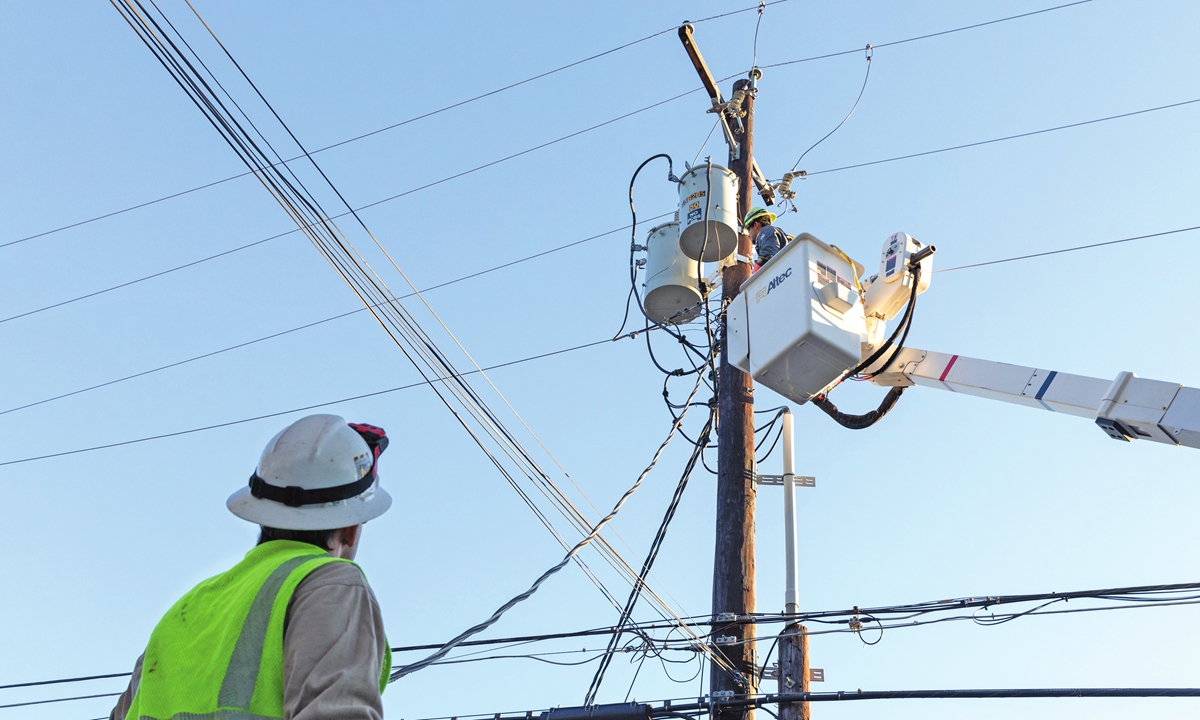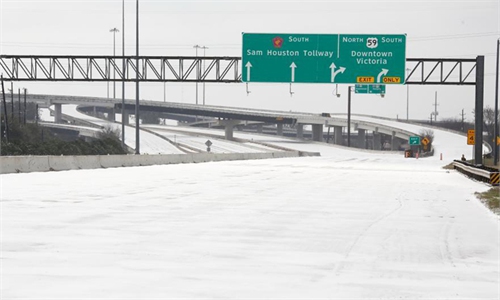As Texans cranked up their heaters early Monday to combat plunging temperatures, a record surge of electricity demand set off a disastrous chain reaction in the state's power grid.

Monday was one of the state's coldest days in over a century - but the unprecedented power crisis was hardly unprecedented as Texas had experienced a somewhat similar disruption during a 2011 cold snap. Still, Texas power producers failed to adequately winter-proof their systems. The state's grid operator underestimated its need for reserve power capacity before the crisis, and then moved glacially to tell utility providers to institute rolling blackouts to protect against a grid meltdown, various experts said.
Two days earlier, the grid suddenly lost 539 megawatts (mW) of power - enough electricity for nearly 108,000 homes, according to operational messages disclosed by the state's primary grid operator, the Electric Reliability Council of Texas (ERCOT).
Texas is the only state in the continental United States with an independent, isolated grid. That allows the state to avoid federal regulation - but also limits its ability to draw emergency power from other grids. ERCOT also operates the only major US grid that doesn't have a capacity market - a system that provides payments to operators to be on standby to supply power during severe weather events.
After over 3 million ERCOT customers lost power in a February 2011 freeze, federal regulators recommended that ERCOT prepare for winter with the same urgency with which does during the peak summer season. Additionally, while ERCOT's reserve power capacity looked good on paper, it did not take into account that many generation units could get knocked offline by freezing weather.
"There were prior severe cold weather events in the Southwest in 1983, 1989, 2003, 2006, 2008, and 2010," Federal Energy Regulatory Commission and North American Electric Reliability Corp staff summarized after investigating the state's 2011 rolling blackouts. "Extensive generator failures overwhelmed ERCOT's reserves, which eventually dropped below the level of safe operation."
This week's cold snap left 4.5 million ERCOT customers without power. More than 14.5 million Texans endured a related
water-supply crisis. About 65,000 customers remained without power as of Saturday afternoon, according to the website PowerOutage.US.
State health officials have linked over two dozen deaths to the power crisis. Officials say the death toll is expected to rise as more bodies are discovered.
Thin power reserve
In Austin, the state's capital, the minimum February temperature usually falls to lows of 5 to 9 degrees Celsius. This past week, temperatures fell as low as -14 degrees Celsius.
In November 2020, ERCOT assured that the grid was prepared to handle such a dire scenario.
Under normal winter conditions, ERCOT forecast it would have about 16,200 mW of power reserves. But under extreme conditions, it predicted a reserve cushion of only about 1,350 mW. That assumed only 23,500 mW of generation outages. During the peak of this week's crisis, more than 30,000 mW was forced off the grid.
Other US grid operators maintain a capacity market to supply extra power in extreme conditions, paying operators on an ongoing basis, whether they produce power or not. Instead, ERCOT relies on a wholesale electricity market, where free-market pricing provides incentives for generators to provide daily power and to make investments to ensure reliability in peak periods, according to economists.
Looming crisis
Since 2010, ERCOT's reserve margin has dropped from 20 to 10 percent. This has put pressure on generators during demand spikes, making the grid less flexible, according to North American Electric Reliability Corporation, a nonprofit regulator.
That thin margin for error set off alarms early Monday morning among energy traders and analysts as they watched a sudden drop in the electrical frequency of the Texas grid.
By Sunday afternoon about 3:15 pm (CST), ERCOT's control room signaled it had run out of options to boost electric generation to match the soaring demand. Operators issued a warning that there was "no market solution" for the projected shortage, according to control room messages published by ERCOT on its website.
Adam Sinn, president of Houston-based energy trading firm Aspire Commodities, said ERCOT waited far too long to start informing utilities providers to cut customers' power to guard against a grid meltdown. The problems, he said, were readily apparent prior to Monday.
Frozen nuclear plant
Early Monday morning, one of the largest sources of electricity in the state - the unit 1 reactor at the South Texas Nuclear Generating Station - stopped producing power after a small section of pipe froze in temperatures that averaged 9 C. The grid lost access to 1,350 MW of nuclear power - enough to power for about 270,000 homes - after automatic sensors detected the frozen pipe and preemptively shut down the reactor, said Victor Dricks, a spokesman for the US Nuclear Regulatory Commission.
Three days later, ERCOT Chief Executive Bill Magness acknowledged that the grid operator had only narrowly avoided the calamity of uncontrolled blackouts.

A worker (right) repairs a power line in Austin, Texas, the US, on Saturday. Photo: VCG
Wind turbines in the state's northern panhandle ceased. Natural gas plants shut down when frozen pipes and components shut off fuel flow. A South Texas nuclear reactor went dark after a 1.5-meter section of uninsulated pipe malfunctioned. Power outages quickly spread statewide, with deadly consequences. It could have been worse; before Monday morning, the state's grid operator was "seconds and minutes" away from an uncontrolled blackout for its 26 million customers, its CEO has said. Such a collapse occurs when operators are unable to manage the crisis through rolling blackouts, which can take weeks, even months to fully restore power to customers.Monday was one of the state's coldest days in over a century - but the unprecedented power crisis was hardly unprecedented as Texas had experienced a somewhat similar disruption during a 2011 cold snap. Still, Texas power producers failed to adequately winter-proof their systems. The state's grid operator underestimated its need for reserve power capacity before the crisis, and then moved glacially to tell utility providers to institute rolling blackouts to protect against a grid meltdown, various experts said.
Two days earlier, the grid suddenly lost 539 megawatts (mW) of power - enough electricity for nearly 108,000 homes, according to operational messages disclosed by the state's primary grid operator, the Electric Reliability Council of Texas (ERCOT).
Texas is the only state in the continental United States with an independent, isolated grid. That allows the state to avoid federal regulation - but also limits its ability to draw emergency power from other grids. ERCOT also operates the only major US grid that doesn't have a capacity market - a system that provides payments to operators to be on standby to supply power during severe weather events.
After over 3 million ERCOT customers lost power in a February 2011 freeze, federal regulators recommended that ERCOT prepare for winter with the same urgency with which does during the peak summer season. Additionally, while ERCOT's reserve power capacity looked good on paper, it did not take into account that many generation units could get knocked offline by freezing weather.
"There were prior severe cold weather events in the Southwest in 1983, 1989, 2003, 2006, 2008, and 2010," Federal Energy Regulatory Commission and North American Electric Reliability Corp staff summarized after investigating the state's 2011 rolling blackouts. "Extensive generator failures overwhelmed ERCOT's reserves, which eventually dropped below the level of safe operation."
This week's cold snap left 4.5 million ERCOT customers without power. More than 14.5 million Texans endured a related
water-supply crisis. About 65,000 customers remained without power as of Saturday afternoon, according to the website PowerOutage.US.
State health officials have linked over two dozen deaths to the power crisis. Officials say the death toll is expected to rise as more bodies are discovered.
Thin power reserve
In Austin, the state's capital, the minimum February temperature usually falls to lows of 5 to 9 degrees Celsius. This past week, temperatures fell as low as -14 degrees Celsius.
In November 2020, ERCOT assured that the grid was prepared to handle such a dire scenario.
Under normal winter conditions, ERCOT forecast it would have about 16,200 mW of power reserves. But under extreme conditions, it predicted a reserve cushion of only about 1,350 mW. That assumed only 23,500 mW of generation outages. During the peak of this week's crisis, more than 30,000 mW was forced off the grid.
Other US grid operators maintain a capacity market to supply extra power in extreme conditions, paying operators on an ongoing basis, whether they produce power or not. Instead, ERCOT relies on a wholesale electricity market, where free-market pricing provides incentives for generators to provide daily power and to make investments to ensure reliability in peak periods, according to economists.
Looming crisis
Since 2010, ERCOT's reserve margin has dropped from 20 to 10 percent. This has put pressure on generators during demand spikes, making the grid less flexible, according to North American Electric Reliability Corporation, a nonprofit regulator.
That thin margin for error set off alarms early Monday morning among energy traders and analysts as they watched a sudden drop in the electrical frequency of the Texas grid.
By Sunday afternoon about 3:15 pm (CST), ERCOT's control room signaled it had run out of options to boost electric generation to match the soaring demand. Operators issued a warning that there was "no market solution" for the projected shortage, according to control room messages published by ERCOT on its website.
Adam Sinn, president of Houston-based energy trading firm Aspire Commodities, said ERCOT waited far too long to start informing utilities providers to cut customers' power to guard against a grid meltdown. The problems, he said, were readily apparent prior to Monday.
Frozen nuclear plant
Early Monday morning, one of the largest sources of electricity in the state - the unit 1 reactor at the South Texas Nuclear Generating Station - stopped producing power after a small section of pipe froze in temperatures that averaged 9 C. The grid lost access to 1,350 MW of nuclear power - enough to power for about 270,000 homes - after automatic sensors detected the frozen pipe and preemptively shut down the reactor, said Victor Dricks, a spokesman for the US Nuclear Regulatory Commission.
Three days later, ERCOT Chief Executive Bill Magness acknowledged that the grid operator had only narrowly avoided the calamity of uncontrolled blackouts.




